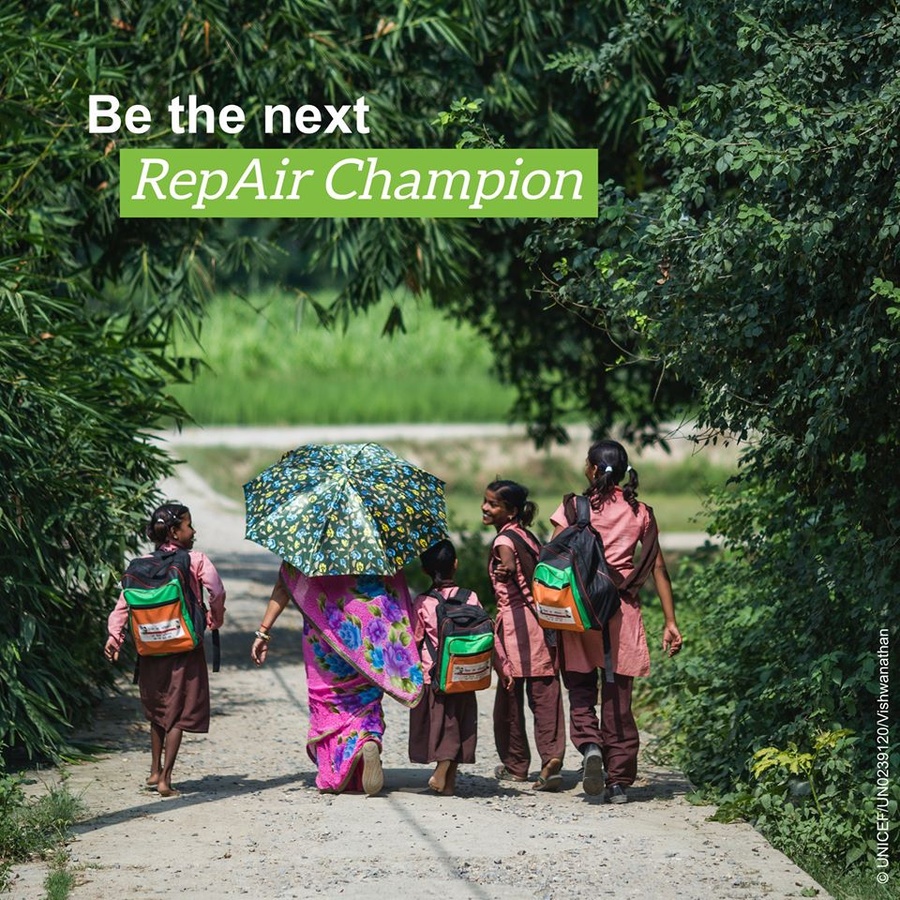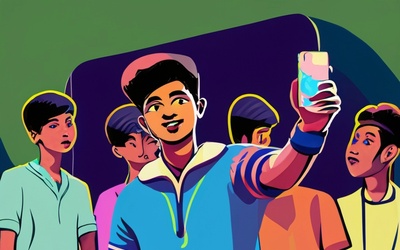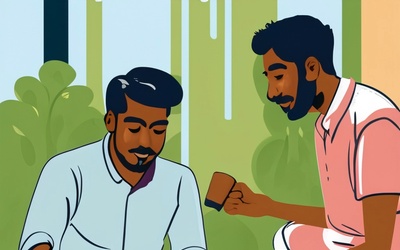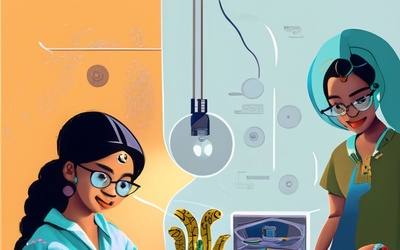The fortnight-1 of RepAir programme that went live on 5th December 2019, tried to understand the public perception on the issue using a set of questions, and subsequently tries to correct their perception through disseminating information materials related to the question. The U-Report platform that can be accessed using several social media platforms such as Facebook messenger and WhatsApp, had seen over 10,500 responses from Jammu & Kashmir to Tamil Nadu and from Assam to Gujarat.
Despite
years of air pollution awareness programs that went in India, the responses we
received on the misconceptions that exist among our larger family should
surprise everyone of us. More than half believes that air pollution in India is
a Delhi-centric issue. But it is not! 76.8 percent of our population is exposed to
air quality that is worse than the nation guidelines, and none of the states in
the country have achieved air quality that is within WHO specified guidelines
for healthy life. Besides, 10 out of top 20 most polluted cities in the world
are in India and and 1.2 million Indian citizens die every year because
of the impacts of air pollution.
When
asked how many of the respondents agree with the statement that toxic air takes
a very long time to harm them, yet again, nearly half of the respondents agreed
to it. But the truth is that all of us can experience health problems even if
we breathe in toxic air for a short period of time. Even the short-term
exposures are linked with lung infections, heart strokes, and hospital visits.
Other perception among the respondents that intrigued us was when nearly half
of the respondents believed that they were immune to the impact of air
pollution as they got used to it. But in reality, we don’t become immune to
toxic air, but over time our body’s immune system loses the fight against toxic
air and often damages our organs. The more we breathe the bad air, the worse
are the impacts. Sometimes the impacts are immediate, and sometimes in long run
such as cancer. From question 5 & 6, it can also be observed that there
existed a gap in the awareness programs that went in past in informing the
public. Not always, the indoor air quality is best. Sometimes the indoor air
quality can be 10 times worse
than the outdoor air pollution, and most of us are not even aware of this fact.
While sometimes the ventilation can impact the indoor air quality bringing in
the toxic air from outside, often there are sources of air pollution within our
homes such as cooking, combustion, smoking, incense sticks, floor cleaners etc. which degrade the quality of
our indoor air. And in fact, this indoor air pollution’s contribution to
outdoor air pollution is estimated to vary between 22 and 52 percent. Until our indoor air quality is
monitored on regular basis we cannot be sure about how good the indoor air
quality at your house, my house or our friends house is. And definitely, the
surgical masks would not stop the Particulate matter from entering your lungs
and further into your blood stream. The little holes in the Surgical masks
(often used by doctors) are too big to stop the particulate matter from
entering your body. There are different filtering masks, often called N95, N99,
N100 and P100 available in the market specific for the particulate matter, that
are capable of filtering out PM2.5 airborne particulate matter with up to
95 percent, 99 percent, and 99.97 percent efficiency accordingly. Not to
forget, while the mask has to fit nice and tight on your face, it cannot
restrict all the types of harmful pollutants in the air. So, read the
specifications of mask you are buying.
Yes! The issue of Air pollution is so complex, and we cannot
address it by some temporary fixes. A collective effort is
needed to align the efforts from diverse stakeholders to produce full spectrum
results that can sustainably address the issue. With more than 80 percent of
our respondents feeling concerned, but also inspired to do something to achieve
healthy air for all, the RepAir program
would build the efforts for a youth-led, youth-focused approach, where we can
promote increased social inclusion, civic engagement, intercultural dialogue
and social innovation, and achieve healthy air for all.
Scroll down to understand the issue of Air Pollution in depth and
how RepAir campaign plans to address the issue with the help of RepAir
champions spread across the country.
Air Pollution: A Killer?
The
quality of the air we breathe is deteriorating both in urban and rural context.
It has been well established that air pollution is associated with adverse
respiratory and cardiovascular outcomes. It is further associated with many
unseen killers of children and continues to affect various population groups
particularly the most vulnerable. Though this public health crisis knows no
geographical boundaries, there is an inherent interrelationship between
socio-economic status and the pervasiveness of ambient and household air
pollution. Simply put, the lower the socioeconomic status, the greater the
exposure to air pollution wherein women and children are disproportionately
impacted. While 12.5% of total number of deaths in India, for the year 2017,
are attributed to air pollution; among these 6.7 lakh deaths are attributed to
outdoor/ambient air pollution and 4.8 lakh deaths to the indoor/household air
pollution. The general understanding is that outdoor air quality influences
indoor air quality due to ventilation air flow. However, the fact that indoor
air pollution contribution to outdoor air pollution in India, which is
estimated to vary between 22 and 52% is often overlooked.
In
low- and middle-income countries globally, 98% of all children under 5 years of
age are exposed to higher levels of PM2.5 levels above WHO air quality
guidelines. Moreover, air pollution is associated with some of the biggest
killer of children, such as pneumonia, which is responsible for the deaths of
9,20,000 children under 5 years of age, every year across the world. Already,
children in urban slums are exposed to environmental deterioration including
lack of clean water and sanitation and disease. Cumulative impact of
air-water-soil pollution will compound the threats and multiply the risks
already associated with inter generational disadvantages due to continued
poverty cycles. Overall, this can result in children missing school days,
deteriorating socio-economic livelihoods and lifelong damage to children’s
health and development.
According to a study, the annual population-weighted mean
exposure to ambient PM2·5 in India was 89·9 μg/m3.
In contrast, the WHO guidelines on air quality recommends an annual mean
exposure not more than 10 μg/m3,
and the Indian National Air Quality standards not more than 40 μg/m3. Premature deaths and many health impacts are attributed
substantially to increased exposure to particulate matter in India. Within
India, air pollution is responsible for 12.5% of all deaths, counting to 12.4
lakh deaths associated with air pollution. Additionally, 8.5 out of every
10,000 children in India die before they reach the age of five due to poor air
quality. For girls, this rate is higher at 9.6 deaths out of every 10,000. According
to Air Quality Life Index (AQLI), bringing down the particulate matter
concentration in the country to WHO guidelines would increase life expectancy
by 4.3 years on average across the country, and is as high as 10.2 years for
citizens living in Delhi (National Capital Region).
The Issue In India:
While the central government has launched the National Clean Air Programme (NCAP) to tackle air pollution problem in certain cities, there is increasing concern that some officials negate the health implications of air pollution and narrow the debate to single sources such as “stubble burning”. Continued emphasis is also placed on temporary solutions such as “odd-even” days when the quality of air is not in the specified limits throughout the year. Air Pollution is a very complex issue due to multiple sources that are attributed to pollution, percentage variability including diurnally or seasonally; and the consequential and targeted policy changes and actions required from multiple sectors, sub-sectors, departments, and citizens. Compounding this complexity are the health impacts which vary considerably depending on multiple socio-economic and personal factors. Over and above, India has a limited network of air quality monitoring stations, which are often restricted to urban areas only. While there may exist a general perception that only the outdoor air quality is toxic due to the pollution from vehicles and industries, which are often the characteristics of urban areas, the deaths and health impacts associated with indoor or household air quality cannot be overseen when 31 to 47 percent of the air pollution related deaths in India were attributed to household air pollution. Deaths due to Childhood Pneumonia in India are second largest in the world in terms of numbers i.e. 1,27,000. In 49% of these deaths the attributable risk is air pollution[1]. Air pollution also contributes to adverse pregnancy outcomes, asthma, tuberculosis, cancers and cognitive impairments. Air pollution risk more acute is common in States of Northern India where under-five and maternal mortality rates are high.
RepAir as a Way
Forward
The issue of Air pollution is complex and cannot be addressed
by some temporary fixes, but needs a collective effort aligning
the efforts from diverse stakeholders. Despite
children being vulnerable to the effects of air pollution, the power of their
voice demanding and advocating for change cannot go unnoticed. Adolescents and
the youth are and will continue to be pivotal change-makers and advocates to improve their communities,
schools, environment, state or country whilst developing a combination of
knowledge, skills, values and motivation to achieve improvements in air
quality.
With
this dimension of programming as a central focus, wherein young people take
leadership to bring together a range of stakeholder to take a multiple level
actions to achieve healthy air for all, UNICEF had launched RepAir programme on 5th December 2019
using a free to access U-Report Platform. The UNICEF’s U-Report platform is a
powerful community participation tool that can help the country to capitalize
on its demographic dividend. Given the potential, in order to have any
realistic transformational impact on air pollution as a phenomenon, the
campaign must organically evolve into a children / youth / peoples’ movement.
It needs to emerge as a collective effort that is not project or funding driven
–but driven by an individual action and collective direction that is rooted in
manifesting universal values of child rights to make a definitive demand for
multi-sectoral system shifts that can contribute to reducing air pollution. This
phase of RepAir programme is spread across 9
fortnights and envisages to make the citizens aware on the issue of air
pollution and its impacts, and to further develop a stewardship by young RepAir Champions. The vision for healthy air would be
led by young people at the local level and upwards by integrating historic and
real time data, local cultural/geographical contexts and the mobilization of
pre-existing and new youth led coordinating groups. By shifting to a youth-led,
youth-focused approach, we plan to promote increased social inclusion, civic
engagement, intercultural dialogue and social innovation amongst overall skills
development to challenge the status quo or business as usual with respect to
air pollution.
Understanding
the need for a wide-spread social and technical capital for such a program, a
reference group composed of experts from diverse backgrounds and organizations
would be formed who would inspire & mentor the children and youth from
across India to be the change that they want to see through networking the
youth showcasing stewardship, making available linkages and technical resources,
and developing leadership of the youth using a series of Transformation
Capacity Development Tools
As a result of the above support from the reference group and UNICEF, youth leaders will be able to see themselves as change agents for a sustainable future and are able to build self-efficacy; help fellow young citizens access/explore knowledge that explains the full complexity of the challenge that they are addressing in an easily understandable form so that their efforts are coherent and transformative; have the right tools & capacities so that they are able to manifest their full potential as leaders/change agents; feels supported and receive appropriate support from within the network and if necessary mentoring when they are in action. This enables the children and youth to find sustainable solutions to the challenges around air pollution, through a collective understanding and collective will.








